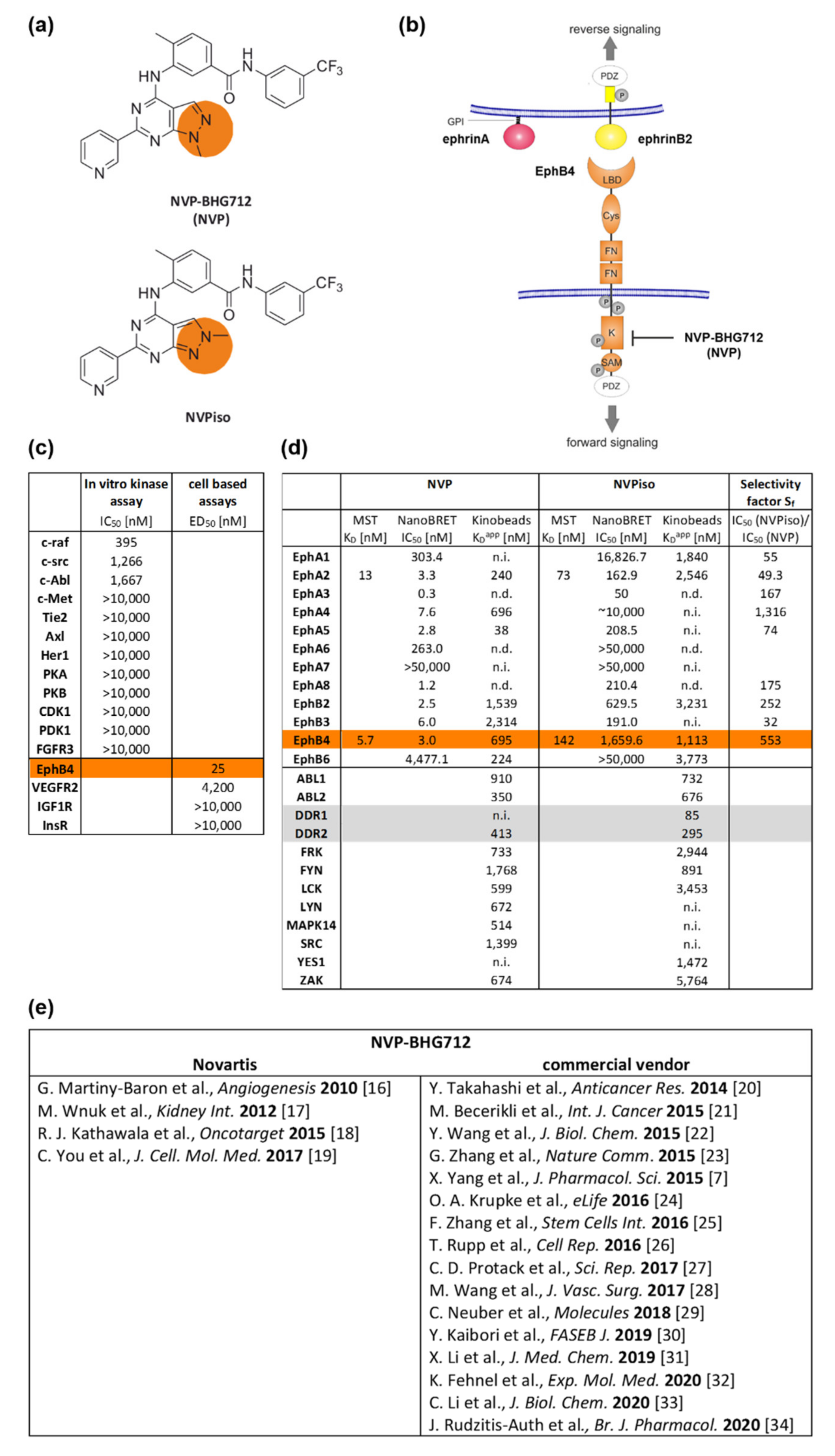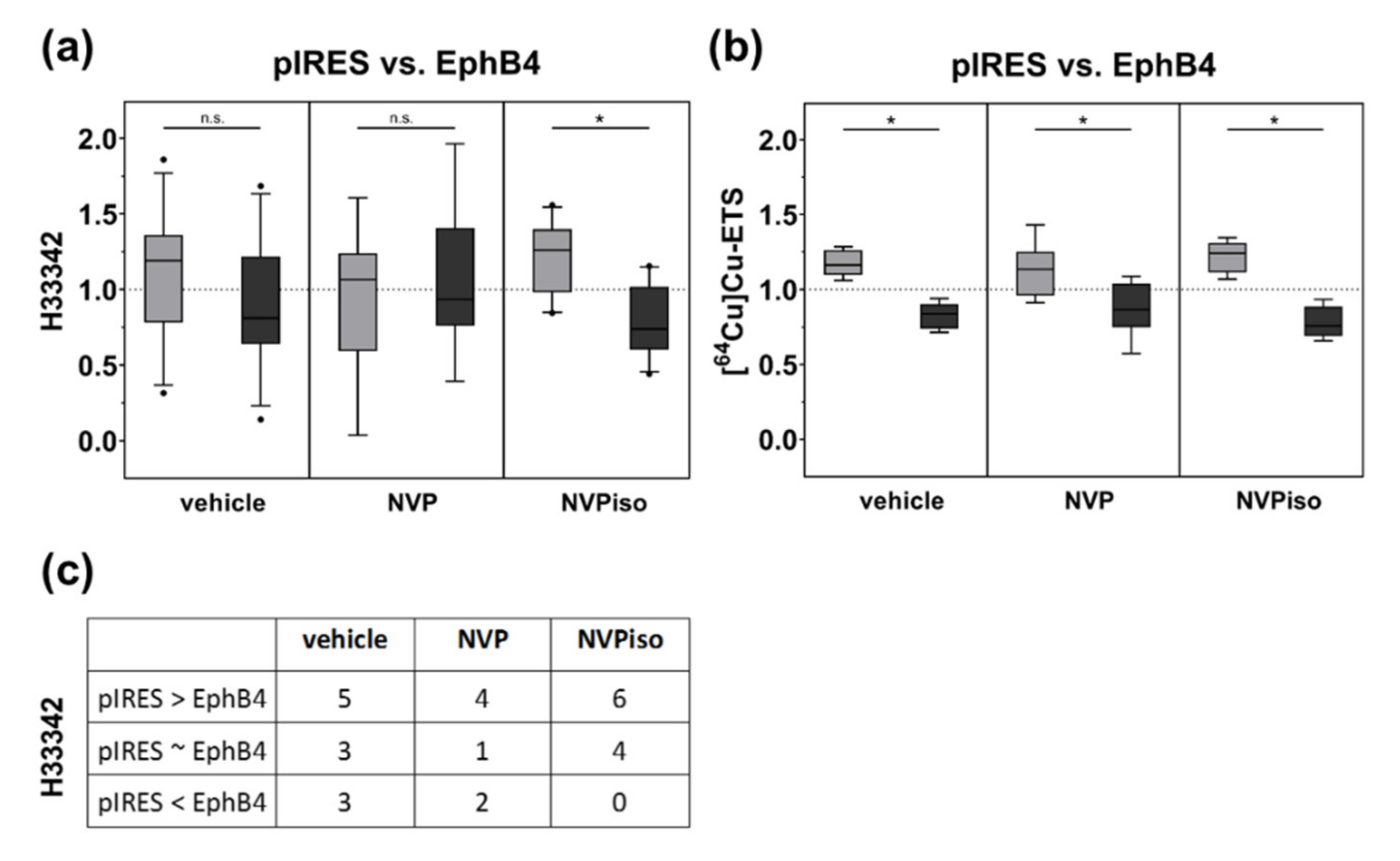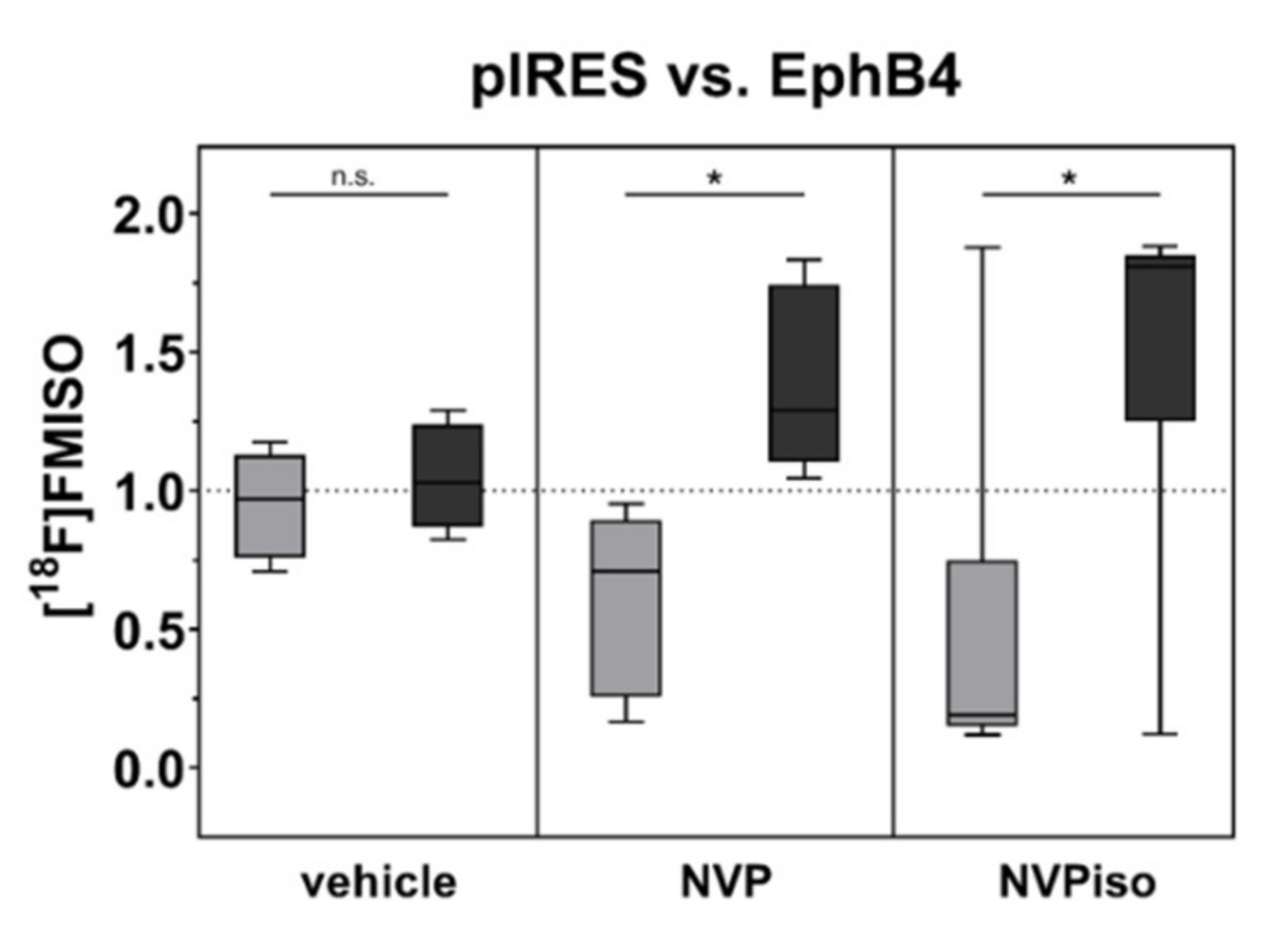The Pyrazolo[3,4-d]pyrimidine-Based Kinase Inhibitor NVP-BHG712: Effects of Regioisomers on Tumor Growth, Perfusion, and Hypoxia in EphB4-Positive A375 Melanoma Xenografts
Abstract
1. Introduction
2. Results
2.1. Tumor Growth
2.2. Tumor Vascularization and Perfusion
2.3. Tumor Hypoxia
2.4. Protein Expression and Phosphorylation Array
3. Discussion
4. Materials and Methods
4.1. Syntheses of NVP-BHG712 (NVP) and NVPiso
4.2. NMR Analysis of the Commercially Acquired ‘NVP’
4.3. Generation of A375 Melanoma Xenografts
4.4. Blocking Experiments with the EphB4 Kinase Inhibitor NVP-BHG712 and NVPiso
4.5. Investigation of Tumor Perfusion and Tumor Hypoxia Using [64Cu]Cu-ETS and [18F]FMISO
4.6. Investigation of Tumor Vascularization Using H33342
4.7. Cryosectioning and Quantitative Analysis of Radioluminography ([64Cu]Cu-ETS, [18F]FMISO) as Well as Fluorescence Microscopy (H33342)
4.8. Protein Expression and Phosphorylation Array
4.9. Statistical Analysis
Supplementary Materials
Author Contributions
Funding
Acknowledgments
Conflicts of Interest
References
- Wang, H.U.; Chen, Z.F.; Anderson, D.J. Molecular distinction and angiogenic interaction between embryonic arteries and veins revealed by ephrin-B2 and its receptor Eph-B4. Cell 1998, 93, 741–753. [Google Scholar] [CrossRef]
- Wang, Y.; Nakayama, M.; Pitulescu, M.E.; Schmidt, T.S.; Bochenek, M.L.; Sakakibara, A.; Adams, S.; Davy, A.; Deutsch, U.; Luthi, U.; et al. Ephrin-B2 controls VEGF-induced angiogenesis and lymphangiogenesis. Nature 2010, 465, 483–486. [Google Scholar] [CrossRef] [PubMed]
- Sawamiphak, S.; Seidel, S.; Essmann, C.L.; Wilkinson, G.A.; Pitulescu, M.E.; Acker, T.; Acker-Palmer, A. Ephrin-B2 regulates VEGFR2 function in developmental and tumour angiogenesis. Nature 2010, 465, 487–491. [Google Scholar] [CrossRef] [PubMed]
- Mosch, B.; Reissenweber, B.; Neuber, C.; Pietzsch, J. Eph receptors and ephrin ligands: Important players in angiogenesis and tumor angiogenesis. J. Oncol. 2010. [Google Scholar] [CrossRef]
- Heroult, M.; Schaffner, F.; Augustin, H.G. Eph receptor and ephrin ligand-mediated interactions during angiogenesis and tumor progression. Exp. Cell Res. 2006, 312, 642–650. [Google Scholar] [CrossRef]
- Guijarro-Munoz, I.; Sanchez, A.; Martinez-Martinez, E.; Garcia, J.M.; Salas, C.; Provencio, M.; Alvarez-Vallina, L.; Sanz, L. Gene expression profiling identifies EPHB4 as a potential predictive biomarker in colorectal cancer patients treated with bevacizumab. Med. Oncol. 2013, 30. [Google Scholar] [CrossRef]
- Yang, X.K.; Yang, Y.D.; Tang, S.Q.; Tang, H.; Yang, G.H.; Xu, Q.Y.; Wu, J.J. EphB4 inhibitor overcome the acquired resistance to cisplatin in melanomas xenograft model. J. Pharmacol. Sci. 2015, 129, 65–71. [Google Scholar] [CrossRef] [PubMed]
- Oweida, A.; Bhatia, S.; Hirsch, K.; Calame, D.; Griego, A.; Keysar, S.; Pitts, T.; Sharma, J.; Eckhardt, G.; Jimeno, A.; et al. Ephrin-B2 overexpression predicts for poor prognosis and response to therapy in solid tumors. Mol. Carcinog. 2017, 56, 1189–1196. [Google Scholar] [CrossRef]
- Bhatia, S.; Karam, S.D. Eph/ephrin family proteins and therapeutic resistance. In Improving the Therapeutic Ratio in Head and Neck Cancer; Kimple, R.J., Ed.; Academic Press: San Diego, CA, USA, 2019; Volume 6. [Google Scholar]
- Krasnoperov, V.; Kumar, S.R.; Ley, E.; Li, X.Q.; Scehnet, J.; Liu, R.; Zozulya, S.; Gill, P.S. Novel EphB4 monoclonal antibodies modulate angiogenesis and inhibit tumor growth. Am. J. Pathol. 2010, 176, 2029–2038. [Google Scholar] [CrossRef] [PubMed]
- Noberini, R.; Lamberto, I.; Pasquale, E.B. Targeting Eph receptors with peptides and small molecules: Progress and challenges. Semin. Cell Dev. Biol. 2012, 23, 51–57. [Google Scholar] [CrossRef]
- Boyd, A.W.; Bartlett, P.F.; Lackmann, M. Therapeutic targeting of EPH receptors and their ligands. Nat. Rev. Drug Discov. 2014, 13, 39–62. [Google Scholar] [CrossRef]
- Tognolini, M.; Hassan-Mohamed, I.; Giorgio, C.; Zanotti, I.; Lodola, A. Therapeutic perspecitves of Eph-ephrin system modulation. Drug Discov. Today 2014, 19, 661–669. [Google Scholar] [CrossRef]
- Neuber, C.; Belter, B.; Mamat, C.; Pietzsch, J. Radiopharmacologist’s and Radiochemist’s View on Targeting the Eph/Ephrin Receptor Tyrosine Kinase System. ACS Omega 2020, 5, 16318–16331. [Google Scholar] [CrossRef]
- Holzer, P.; Imbach, P.; Furet, P.; Schmiedeberg, N. 3-(Substituted Amino)-Pyrazolo[3,4-d]Pyrimidines as EphB and VEGFR2 Kinase Inhibitors. WO 2007/062805, 7 June 2007. [Google Scholar]
- Martiny-Baron, G.; Holzer, P.; Billy, E.; Schnell, C.; Brueggen, J.; Ferretti, M.; Schmiedeberg, N.; Wood, J.M.; Furet, P.; Imbach, P. The small molecule specific EphB4 kinase inhibitor NVP-BHG712 inhibits VEGF driven angiogenesis. Angiogenesis 2010, 13, 259–267. [Google Scholar] [CrossRef]
- Wnuk, M.; Hlushchuk, R.; Janot, M.; Tuffin, G.; Martiny-Baron, G.; Holzer, P.; Imbach-Weese, P.; Djonov, V.; Huynh-Do, U. Podocyte EphB4 signaling helps recovery from glomerular injury. Kidney Int. 2012, 81, 1212–1225. [Google Scholar] [CrossRef]
- Kathawala, R.J.; Wei, L.Y.; Anreddy, N.; Chen, K.; Patel, A.; Alqahtani, S.; Zhang, Y.K.; Wang, Y.J.; Sodani, K.; Kaddoumi, A.; et al. The small molecule tyrosine kinase inhibitor NVP-BHG712 antagonizes ABCC10-mediated paclitaxel resistance: A preclinical and pharmacokinetic study. Oncotarget 2015, 6, 510–521. [Google Scholar] [CrossRef]
- You, C.; Zhao, K.; Dammann, P.; Keyvani, K.; Kreitschmann-Andermahr, I.; Sure, U.; Zhu, Y. EphB4 forward signalling mediates angiogenesis caused by CCM3/PDCD10-ablation. J. Cell. Mol. Med. 2017, 21, 1848–1858. [Google Scholar] [CrossRef]
- Takahashi, Y.; Itoh, M.; Nara, N.; Tohda, S. Effect of EPH-ephrin signaling on the growth of human leukemia cells. Anticancer Res. 2014, 34, 2913–2918. [Google Scholar]
- Becerikli, M.; Merwart, B.; Lam, M.C.; Suppelna, P.; Rittig, A.; Mirmohammedsadegh, A.; Stricker, I.; Theiss, C.; Singer, B.B.; Jacobsen, F.; et al. EPHB4 tyrosine-kinase receptor expression and biological significance in soft tissue sarcoma. Int. J. Cancer 2015, 136, 1781–1791. [Google Scholar] [CrossRef]
- Wang, Y.; Thorin, E.; Luo, H.; Tremblay, J.; Lavoie, J.L.; Wu, Z.; Peng, J.; Qi, S.; Wu, J. EPHB4 Protein Expression in Vascular Smooth Muscle Cells Regulates Their Contractility, and EPHB4 Deletion Leads to Hypotension in Mice. J. Biol. Chem. 2015, 290, 14235–14244. [Google Scholar] [CrossRef]
- Zhang, G.; Brady, J.; Liang, W.C.; Wu, Y.; Henkemeyer, M.; Yan, M.H. EphB4 forward signalling regulates lymphatic valve development. Nat. Commun. 2015, 6. [Google Scholar] [CrossRef]
- Krupke, O.A.; Zysk, I.; Mellott, D.O.; Burke, R.D. Eph and Ephrin function in dispersal and epithelial insertion of pigmented immunocytes in sea urchin embryos. eLife 2016, 5. [Google Scholar] [CrossRef]
- Zhang, F.; Zhang, Z.; Sun, D.; Dong, S.; Xu, J.; Dai, F. Periostin: A Downstream Mediator of EphB4-Induced Osteogenic Differentiation of Human Bone Marrow-Derived Mesenchymal Stem Cells. Stem Cells Int. 2016. [Google Scholar] [CrossRef]
- Rupp, T.; Langlois, B.; Koczorowska, M.M.; Radwanska, A.; Sun, Z.; Hussenet, T.; Lefebvre, O.; Murdamoothoo, D.; Arnold, C.; Klein, A.; et al. Tenascin-C Orchestrates Glioblastoma Angiogenesis by Modulation of Pro- and Anti-angiogenic Signaling. Cell Rep. 2016, 17, 2607–2619. [Google Scholar] [CrossRef]
- Protack, C.D.; Foster, T.R.; Hashimoto, T.; Yamamoto, K.; Lee, M.Y.; Kraehling, J.R.; Bai, H.; Hu, H.; Isaji, T.; Santana, J.M.; et al. Eph-B4 regulates adaptive venous remodeling to improve arteriovenous fistula patency. Sci. Rep. 2017, 7. [Google Scholar] [CrossRef] [PubMed]
- Wang, M.; Collins, M.J.; Foster, T.R.; Bai, H.; Hashimoto, T.; Santana, J.M.; Shu, C.; Dardik, A. Eph-B4 mediates vein graft adaptation by regulation of endothelial nitric oxide synthase. J. Vasc. Surg. 2017, 65, 179–189. [Google Scholar] [CrossRef]
- Neuber, C.; Belter, B.; Meister, S.; Hofheinz, F.; Bergmann, R.; Pietzsch, H.J.; Pietzsch, J. Overexpression of Receptor Tyrosine Kinase EphB4 Triggers Tumor Growth and Hypoxia in A375 Melanoma Xenografts: Insights from Multitracer Small Animal Imaging Experiments. Molecules 2018, 23, 444. [Google Scholar] [CrossRef]
- Kaibori, Y.; Saito, Y.; Nakayama, Y. EphA2 phosphorylation at Ser897 by the Cdk1/MEK/ERK/RSK pathway regulates M-phase progression via maintenance of cortical rigidity. FASEB J. 2019, 33, 5334–5349. [Google Scholar] [CrossRef]
- Li, X.; Li, Z.; Wu, X.; Xiong, Z.; Yang, T.; Fu, Z.; Liu, X.; Tan, X.; Zhong, F.; Wan, X.; et al. Deep Learning Enhancing Kinome-Wide Polypharmacology Profiling: Model Construction and Experiment Validation. J. Med. Chem. 2019. [Google Scholar] [CrossRef]
- Fehnel, K.P.; Penn, D.L.; Duggins-Warf, M.; Gruber, M.; Pineda, S.; Sesen, J.; Moses-Gardner, A.; Shah, N.; Driscoll, J.; Zurakowski, D.; et al. Dysregulation of the EphrinB2-EphB4 ratio in pediatric cerebral arteriovenous malformations is associated with endothelial cell dysfunction in vitro and functions as a novel noninvasive biomarker in patients. Exp. Mol. Med. 2020, 52, 658–671. [Google Scholar] [CrossRef]
- Li, C.; Lanman, N.A.; Kong, Y.; He, D.; Mao, F.; Farah, E.; Zhang, Y.; Liu, J.; Wang, C.; Wei, Q.; et al. Inhibition of the erythropoietin-producing receptor EPHB4 antagonizes androgen receptor overexpression and reduces enzalutamide resistance. J. Biol. Chem. 2020, 295, 5470–5483. [Google Scholar] [CrossRef]
- Rudzitis-Auth, J.; Fuss, S.A.; Becker, V.; Menger, M.D.; Laschke, M.W. Inhibition of erythropoietin-producing hepatoma receptor B4 (EphB4) signalling suppresses the vascularisation and growth of endometriotic lesions. Br. J. Pharmacol. 2020, 177, 3225–3239. [Google Scholar] [CrossRef]
- Tröster, A.; Heinzlmeir, S.; Berger, B.T.; Gande, S.L.; Saxena, K.; Sreeramulu, S.; Linhard, V.; Nasiri, A.H.; Bolte, M.; Muller, S.; et al. NVP-BHG712: Effects of Regioisomers on the Affinity and Selectivity toward the EPHrin Family. ChemMedChem 2018, 13, 1629–1633. [Google Scholar] [CrossRef] [PubMed]
- Muz, B.; de la Puente, P.; Azab, F.; Azab, A.K. The role of hypoxia in cancer progression, angiogenesis, metastasis, and resistance to therapy. Hypoxia 2015, 3, 83–92. [Google Scholar] [CrossRef] [PubMed]
- Colliez, F.; Gallez, B.; Jordan, B.F. Assessing Tumor Oxygenation for Predicting Outcome in Radiation Oncology: A Review of Studies Correlating Tumor Hypoxic Status and Outcome in the Preclinical and Clinical Settings. Front. Oncol. 2017, 7. [Google Scholar] [CrossRef]
- Tredan, O.; Galmarini, C.M.; Patel, K.; Tannock, I.F. Drug resistance and the solid tumor microenvironment. J. Natl. Cancer Inst. 2007, 99, 1441–1454. [Google Scholar] [CrossRef]
- Tarasov, V.V.; Chubarev, V.N.; Ashraf, G.M.; Dostdar, S.A.; Sokolov, A.V.; Melnikova, T.I.; Sologova, S.S.; Grigorevskich, E.M.; Makhmutovsmall, C.A.; Kinzirsky, A.S.; et al. How Cancer Cells Resist Chemotherapy: Design and Development of Drugs Targeting Protein-Protein Interactions. Curr. Top. Med. Chem. 2019, 19, 394–412. [Google Scholar] [CrossRef]
- Gucciardo, E.; Sugiyama, N.; Lehti, K. Eph- and ephrin-dependent mechanisms in tumor and stem cell dynamics. Cell. Mol. Life Sci. 2014, 71, 3685–3710. [Google Scholar] [CrossRef]
- Jiang, B.H.; Liu, L.Z. AKT signaling in regulating angiogenesis. Curr. Cancer Drug Targets 2008, 8, 19–26. [Google Scholar] [CrossRef]
- Cobas, C.; Dominguez, S.; Larin, N.; Iglesias, I.; Geada, C.; Seoane, F.; Sordo, M.; Monje, H.; Fraga, S.; Cobas, R.; et al. MestReNova 6.1.1-6384; Mestrelab Research S.L.: Santiago de Compostela, Spain, 2010. [Google Scholar]
- Mamat, C.; Mosch, B.; Neuber, C.; Köckerling, M.; Bergmann, R.; Pietzsch, J. Fluorine-18 Radiolabeling and Radiopharmacological Characterization of a Benzodioxolylpyrimidine-based Radiotracer Targeting the Receptor Tyrosine Kinase EphB4. ChemMedChem 2012, 7, 1991–2003. [Google Scholar] [CrossRef]
- Schindelin, J.; Arganda-Carreras, I.; Frise, E.; Kaynig, V.; Longair, M.; Pietzsch, T.; Preibisch, S.; Rueden, C.; Saalfeld, S.; Schmid, B.; et al. Fiji: An open-source platform for biological-image analysis. Nat. Methods 2012, 9, 676–682. [Google Scholar] [CrossRef]
Sample Availability: Samples of the compounds NVP and NPViso are available from the authors (H.S., A.T.). |





Publisher’s Note: MDPI stays neutral with regard to jurisdictional claims in published maps and institutional affiliations. |
© 2020 by the authors. Licensee MDPI, Basel, Switzerland. This article is an open access article distributed under the terms and conditions of the Creative Commons Attribution (CC BY) license (http://creativecommons.org/licenses/by/4.0/).
Share and Cite
Neuber, C.; Tröster, A.; Löser, R.; Belter, B.; Schwalbe, H.; Pietzsch, J. The Pyrazolo[3,4-d]pyrimidine-Based Kinase Inhibitor NVP-BHG712: Effects of Regioisomers on Tumor Growth, Perfusion, and Hypoxia in EphB4-Positive A375 Melanoma Xenografts. Molecules 2020, 25, 5115. https://doi.org/10.3390/molecules25215115
Neuber C, Tröster A, Löser R, Belter B, Schwalbe H, Pietzsch J. The Pyrazolo[3,4-d]pyrimidine-Based Kinase Inhibitor NVP-BHG712: Effects of Regioisomers on Tumor Growth, Perfusion, and Hypoxia in EphB4-Positive A375 Melanoma Xenografts. Molecules. 2020; 25(21):5115. https://doi.org/10.3390/molecules25215115
Chicago/Turabian StyleNeuber, Christin, Alix Tröster, Reik Löser, Birgit Belter, Harald Schwalbe, and Jens Pietzsch. 2020. "The Pyrazolo[3,4-d]pyrimidine-Based Kinase Inhibitor NVP-BHG712: Effects of Regioisomers on Tumor Growth, Perfusion, and Hypoxia in EphB4-Positive A375 Melanoma Xenografts" Molecules 25, no. 21: 5115. https://doi.org/10.3390/molecules25215115
APA StyleNeuber, C., Tröster, A., Löser, R., Belter, B., Schwalbe, H., & Pietzsch, J. (2020). The Pyrazolo[3,4-d]pyrimidine-Based Kinase Inhibitor NVP-BHG712: Effects of Regioisomers on Tumor Growth, Perfusion, and Hypoxia in EphB4-Positive A375 Melanoma Xenografts. Molecules, 25(21), 5115. https://doi.org/10.3390/molecules25215115







